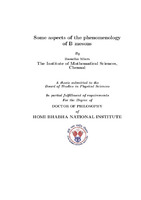- DSpace Home
- →
- IMSc Theses/ Dissertations
- →
- IMSc Theses/ Dissertations
- →
- View Item
JavaScript is disabled for your browser. Some features of this site may not work without it.
| dc.contributor.author | Basudha Misra | |
| dc.date.accessioned | 2010-10-05T08:45:36Z | |
| dc.date.available | 2010-10-05T08:45:36Z | |
| dc.date.issued | 2010 | |
| dc.date.submitted | 2010 | |
| dc.identifier.uri | https://dspace.imsc.res.in/xmlui/handle/123456789/237 | |
| dc.description.abstract | The variation of the measured (B^0 d − ((B^0)bar) d) mixing phase β/φ1 in b → cc(bar)s and b → sq(bar)q (where q = u, d, s) modes is regarded as a possible probe of New Physics. It has been speculated that this discrepancy is a signal of New Physics. Within the Standard Model the amplitude for modes involving b → s transitions, get contributions from two amplitudes with different weak phases. Unless the contribution from one of the amplitudes is negligible, one would expect some discrepancy between the various measurements. Estimates of this discrepancy using hadronic assumptions have indicated that the sign of the discrepancy within SM is opposite to the observed value. We demonstrate using a model independent approach that the deviation in measured B0 d−B0 d mixing phase caused by pollution from another amplitude, within the Standard Model, is always less in magnitude, and has the same sign as the weak phase of the polluting amplitude. The exception is to have large destructive interference between the two amplitudes. We show that any deviation larger than a few degrees is only possible if the observed decay rate results from fine tuned cancellations between significantly larger quark level amplitudes. These simple observations have very significant consequences for signals of New Physics. One of the eligible New Physics candidate is the leptoquark model. Leptoquarks are hypothetical gauge particles which can be either scalar or vector. These particles allow having tree level transitions from a quark to lepton or vice versa which are not permitted in the standard model. In our work, upper bounds at the weak scale are obtained for all λijλik type product couplings of leptoquark model which may affect K0 −K0 , B0 d −B0 d and B0 s −B0 s mixing. For B0 d−B0 d we use both mB and sin(2β) where as for B0 s−B0 s we use mBs and sin(2βs) constraints. For K0 − K0 we use the results on Delta mK and εK. Due to the presence of large theoretical uncertainties, ε′/ε is not considered in our analysis. The relevant mixing correlated leptonic and semileptonic decay channels are also presented in the analysis. We constrain all the possible product couplings in this sector, including some which were not considered earlier. The constraints obtained for the leptonic and semi-leptonic decay modes are much tighter than the bounds obtained from mixing for most of the cases. We also present the bounds on the real and imaginary parts of λλ which carry the information of the phase of new physics. This is a new observation, not considered in earlier literature. | en_US |
| dc.publisher.publisher | The Institute of Mathematical Sciences | |
| dc.relation.isbasedon | List of Publications:- • Rahul Sinha, Basudha Misra, Wei-shu Hou “ Has new physics already been seen in Bd meson decays?”, Phys. Rev. Lett. 97, 131802, 2006. • Basudha Misra, Jyoti Prasad Saha, Prasanta Kumar Das “ Bs → μ+μ− decay in the Randall-Sundrum model”, Phys. Rev. D74, 074011, 2006. • D.Indumathi, Basudha Misra, “An extended model for nonet pseudoscalar meson fragmentation”, arXiv:hep-ph/0901.0228, 2009. • Jyoti Prasad Saha, Basudha Misra, Anirban Kundu “ Constraining Scalar Leptoquarks from the K and B Sectors”, arXiv:hepph/ 1003.1384, 2010 (accepted for publication in Physical Review D). This thesis is based on the following two publications • Rahul Sinha, Basudha Misra, Wei-shu Hou “ Has new physics already been seen in Bd meson decays?”, Phys. Rev. Lett. 97, 131802, 2006. • Jyoti Prasad Saha, Basudha Misra, Anirban Kundu “ Constraining Scalar Leptoquarks from the K and B Sectors”, arXiv:hepph/ 1003.1384, 2010 (accepted for publication in Physical Review D). | en_US |
| dc.subject | B Mesons | en_US |
| dc.subject | LeptoQuarks | en_US |
| dc.subject | HBNI Th23 | en_US |
| dc.title | Some Aspects of the Phenomenology of B Mesons [HBNI Th23] | en_US |
| dc.type.degree | Ph.D | en_US |
| dc.type.institution | HBNI | en_US |
| dc.description.advisor | Rahul Sinha | |
| dc.description.advisor | Indumathi, D. | |
| dc.description.pages | 94p. | en_US |
| dc.type.mainsub | Physics | en_US |
| dc.type.hbnibos | Physical Sciences |
Files in this item
This item appears in the following Collection(s)
-
IMSc Theses/ Dissertations
IMSc Theses/ Dissertations
